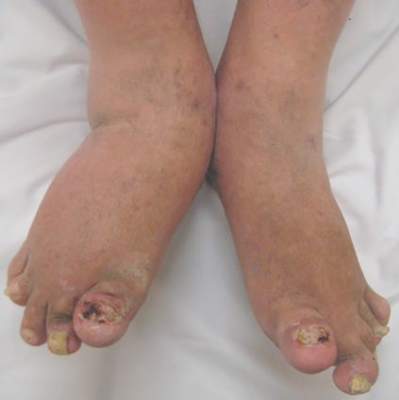User login
ACIP Releases 2015-2016 Flu Vaccine Recommendations
Influenza vaccination is recommended for all patients aged 6 months and older, as long as they don’t have a contraindication, according to a report Aug. 7 in Morbidity and Mortality Weekly Report.
Trivalent influenza vaccines for the 2015-2016 season will contain hemagglutinin (HA) derived from an H1N1-like virus, an H3N2-like virus, and a B/Phuket/3073/2013-like (Yamagata lineage) virus. Quadrivalent vaccines will contain those components, as well as a B/Brisbane/60/2008-like (Victoria lineage) virus, the same virus recommended for quadrivalent formulations in the 2013-14 and 2014-15 seasons, ACIP said in a statement.
New FDA-approved vaccines include Afluria, the Fluzone Intradermal Quadrivalent vaccine (both approved in 2014 for adults aged 18-64 years), and an expanded age indication for Flublok, which is now indicated for adults aged 18 years and older.
The live attenuated influenza vaccine (LAIV) should not be used in certain populations, including those aged less than 2 years or greater than 49 years; children aged 2-17 years taking aspirin; pateints with severe allergic reactions to the vaccine; pregnant women; and those with egg allergies, among others. Either the LAIV or the inactivated influenza vaccine (IIV) is appropriate for administration in healthy children aged 2-8 years, ACIP said.
For a detailed explanation of the recommendations, see MMWR.
Influenza vaccination is recommended for all patients aged 6 months and older, as long as they don’t have a contraindication, according to a report Aug. 7 in Morbidity and Mortality Weekly Report.
Trivalent influenza vaccines for the 2015-2016 season will contain hemagglutinin (HA) derived from an H1N1-like virus, an H3N2-like virus, and a B/Phuket/3073/2013-like (Yamagata lineage) virus. Quadrivalent vaccines will contain those components, as well as a B/Brisbane/60/2008-like (Victoria lineage) virus, the same virus recommended for quadrivalent formulations in the 2013-14 and 2014-15 seasons, ACIP said in a statement.
New FDA-approved vaccines include Afluria, the Fluzone Intradermal Quadrivalent vaccine (both approved in 2014 for adults aged 18-64 years), and an expanded age indication for Flublok, which is now indicated for adults aged 18 years and older.
The live attenuated influenza vaccine (LAIV) should not be used in certain populations, including those aged less than 2 years or greater than 49 years; children aged 2-17 years taking aspirin; pateints with severe allergic reactions to the vaccine; pregnant women; and those with egg allergies, among others. Either the LAIV or the inactivated influenza vaccine (IIV) is appropriate for administration in healthy children aged 2-8 years, ACIP said.
For a detailed explanation of the recommendations, see MMWR.
Influenza vaccination is recommended for all patients aged 6 months and older, as long as they don’t have a contraindication, according to a report Aug. 7 in Morbidity and Mortality Weekly Report.
Trivalent influenza vaccines for the 2015-2016 season will contain hemagglutinin (HA) derived from an H1N1-like virus, an H3N2-like virus, and a B/Phuket/3073/2013-like (Yamagata lineage) virus. Quadrivalent vaccines will contain those components, as well as a B/Brisbane/60/2008-like (Victoria lineage) virus, the same virus recommended for quadrivalent formulations in the 2013-14 and 2014-15 seasons, ACIP said in a statement.
New FDA-approved vaccines include Afluria, the Fluzone Intradermal Quadrivalent vaccine (both approved in 2014 for adults aged 18-64 years), and an expanded age indication for Flublok, which is now indicated for adults aged 18 years and older.
The live attenuated influenza vaccine (LAIV) should not be used in certain populations, including those aged less than 2 years or greater than 49 years; children aged 2-17 years taking aspirin; pateints with severe allergic reactions to the vaccine; pregnant women; and those with egg allergies, among others. Either the LAIV or the inactivated influenza vaccine (IIV) is appropriate for administration in healthy children aged 2-8 years, ACIP said.
For a detailed explanation of the recommendations, see MMWR.
ACIP releases 2015-2016 flu vaccine recommendations
Influenza vaccination is recommended for all patients aged 6 months and older, as long as they don’t have a contraindication, according to a report Aug. 7 in Morbidity and Mortality Weekly Report.
Trivalent influenza vaccines for the 2015-2016 season will contain hemagglutinin (HA) derived from an H1N1-like virus, an H3N2-like virus, and a B/Phuket/3073/2013-like (Yamagata lineage) virus. Quadrivalent vaccines will contain those components, as well as a B/Brisbane/60/2008-like (Victoria lineage) virus, the same virus recommended for quadrivalent formulations in the 2013-14 and 2014-15 seasons, ACIP said in a statement.
New FDA-approved vaccines include Afluria, the Fluzone Intradermal Quadrivalent vaccine (both approved in 2014 for adults aged 18-64 years), and an expanded age indication for Flublok, which is now indicated for adults aged 18 years and older.
The live attenuated influenza vaccine (LAIV) should not be used in certain populations, including those aged less than 2 years or greater than 49 years; children aged 2-17 years taking aspirin; pateints with severe allergic reactions to the vaccine; pregnant women; and those with egg allergies, among others. Either the LAIV or the inactivated influenza vaccine (IIV) is appropriate for administration in healthy children aged 2-8 years, ACIP said.
For a detailed explanation of the recommendations, see MMWR.
Influenza vaccination is recommended for all patients aged 6 months and older, as long as they don’t have a contraindication, according to a report Aug. 7 in Morbidity and Mortality Weekly Report.
Trivalent influenza vaccines for the 2015-2016 season will contain hemagglutinin (HA) derived from an H1N1-like virus, an H3N2-like virus, and a B/Phuket/3073/2013-like (Yamagata lineage) virus. Quadrivalent vaccines will contain those components, as well as a B/Brisbane/60/2008-like (Victoria lineage) virus, the same virus recommended for quadrivalent formulations in the 2013-14 and 2014-15 seasons, ACIP said in a statement.
New FDA-approved vaccines include Afluria, the Fluzone Intradermal Quadrivalent vaccine (both approved in 2014 for adults aged 18-64 years), and an expanded age indication for Flublok, which is now indicated for adults aged 18 years and older.
The live attenuated influenza vaccine (LAIV) should not be used in certain populations, including those aged less than 2 years or greater than 49 years; children aged 2-17 years taking aspirin; pateints with severe allergic reactions to the vaccine; pregnant women; and those with egg allergies, among others. Either the LAIV or the inactivated influenza vaccine (IIV) is appropriate for administration in healthy children aged 2-8 years, ACIP said.
For a detailed explanation of the recommendations, see MMWR.
Influenza vaccination is recommended for all patients aged 6 months and older, as long as they don’t have a contraindication, according to a report Aug. 7 in Morbidity and Mortality Weekly Report.
Trivalent influenza vaccines for the 2015-2016 season will contain hemagglutinin (HA) derived from an H1N1-like virus, an H3N2-like virus, and a B/Phuket/3073/2013-like (Yamagata lineage) virus. Quadrivalent vaccines will contain those components, as well as a B/Brisbane/60/2008-like (Victoria lineage) virus, the same virus recommended for quadrivalent formulations in the 2013-14 and 2014-15 seasons, ACIP said in a statement.
New FDA-approved vaccines include Afluria, the Fluzone Intradermal Quadrivalent vaccine (both approved in 2014 for adults aged 18-64 years), and an expanded age indication for Flublok, which is now indicated for adults aged 18 years and older.
The live attenuated influenza vaccine (LAIV) should not be used in certain populations, including those aged less than 2 years or greater than 49 years; children aged 2-17 years taking aspirin; pateints with severe allergic reactions to the vaccine; pregnant women; and those with egg allergies, among others. Either the LAIV or the inactivated influenza vaccine (IIV) is appropriate for administration in healthy children aged 2-8 years, ACIP said.
For a detailed explanation of the recommendations, see MMWR.
PsA disease activity and treatment success defined
New criteria that define psoriatic arthritis disease activity and treatment response establish cutpoints and percentage changes on the Disease Activity Index for Psoriatic Arthritis scores, Dr. Monika M. Schoels of the Second Department of Internal Medicine at Hietzing Hospital, Vienna, and her coauthors reported.
Dr. Schoels and her colleagues collected 30 patient profiles from an observational data set and then surveyed 44 rheumatology experts (getting 33 responses) to assess the patients’ disease activity based on swollen joint count, tender joint count, global activity, C-reactive protein, and pain ratings. Based on the distribution of Disease Activity Index for Psoriatic Arthritis (DAPSA) scores in the patient population, the investigators then calculated the 25th and 75th percentiles to determine the thresholds for different disease states.
Based on the results, the investigators suggested cutoff values of 4 or less for remission, more than 4 and up to 14 for low disease activity, more than 14 and up to 28 for moderate disease activity, and greater than 28 for high disease activity.
They also found that percentage changes of 50%, 75%, and 85% on the DAPSA corresponded to minor, moderate, and major treatment responses based on American College of Rheumatology 20, 50, and 70 responses observed in three randomized trials.
The study findings provide a “definition of treatment targets … as well as the definition of inclusion criteria for clinical trials for patients in” moderate and high disease activity, Dr. Schoels and her colleagues wrote. “The new response levels will help assess treatment in many settings.”
Read the full study in Annals of the Rheumatic Diseases.
New criteria that define psoriatic arthritis disease activity and treatment response establish cutpoints and percentage changes on the Disease Activity Index for Psoriatic Arthritis scores, Dr. Monika M. Schoels of the Second Department of Internal Medicine at Hietzing Hospital, Vienna, and her coauthors reported.
Dr. Schoels and her colleagues collected 30 patient profiles from an observational data set and then surveyed 44 rheumatology experts (getting 33 responses) to assess the patients’ disease activity based on swollen joint count, tender joint count, global activity, C-reactive protein, and pain ratings. Based on the distribution of Disease Activity Index for Psoriatic Arthritis (DAPSA) scores in the patient population, the investigators then calculated the 25th and 75th percentiles to determine the thresholds for different disease states.
Based on the results, the investigators suggested cutoff values of 4 or less for remission, more than 4 and up to 14 for low disease activity, more than 14 and up to 28 for moderate disease activity, and greater than 28 for high disease activity.
They also found that percentage changes of 50%, 75%, and 85% on the DAPSA corresponded to minor, moderate, and major treatment responses based on American College of Rheumatology 20, 50, and 70 responses observed in three randomized trials.
The study findings provide a “definition of treatment targets … as well as the definition of inclusion criteria for clinical trials for patients in” moderate and high disease activity, Dr. Schoels and her colleagues wrote. “The new response levels will help assess treatment in many settings.”
Read the full study in Annals of the Rheumatic Diseases.
New criteria that define psoriatic arthritis disease activity and treatment response establish cutpoints and percentage changes on the Disease Activity Index for Psoriatic Arthritis scores, Dr. Monika M. Schoels of the Second Department of Internal Medicine at Hietzing Hospital, Vienna, and her coauthors reported.
Dr. Schoels and her colleagues collected 30 patient profiles from an observational data set and then surveyed 44 rheumatology experts (getting 33 responses) to assess the patients’ disease activity based on swollen joint count, tender joint count, global activity, C-reactive protein, and pain ratings. Based on the distribution of Disease Activity Index for Psoriatic Arthritis (DAPSA) scores in the patient population, the investigators then calculated the 25th and 75th percentiles to determine the thresholds for different disease states.
Based on the results, the investigators suggested cutoff values of 4 or less for remission, more than 4 and up to 14 for low disease activity, more than 14 and up to 28 for moderate disease activity, and greater than 28 for high disease activity.
They also found that percentage changes of 50%, 75%, and 85% on the DAPSA corresponded to minor, moderate, and major treatment responses based on American College of Rheumatology 20, 50, and 70 responses observed in three randomized trials.
The study findings provide a “definition of treatment targets … as well as the definition of inclusion criteria for clinical trials for patients in” moderate and high disease activity, Dr. Schoels and her colleagues wrote. “The new response levels will help assess treatment in many settings.”
Read the full study in Annals of the Rheumatic Diseases.
Febuxostat better than allopurinol for preventing tumor lysis syndrome
Febuxostat achieved significantly better serum uric acid control, compared with allopurinol, important for the prevention of tumor lysis syndrome (TLS), reported Dr. Michele Spina and coauthors from the division of medical oncology at the National Cancer Institute in Aviano, Italy.
Serum uric acid control is of key relevance in tumor lysis syndrome prevention as it correlates with both tumor lysis syndrome (TLS) and renal events risk, the investigators said.
In a randomized trial of 346 patients with hematologic malignancies and intermediate to high TLS risk, patients were given either a fixed dose of 120 mg of febuxostat or a dose of allopurinol at either 200, 300, or 600 mg. Febuxostat performed significantly better than allopurinol in reducing serum uric acid (P less than .0001). Both drugs achieved similar renal function preservation (P = .0903) and drug-related adverse events were reported in 6.4% of patients in both treatment arms.
The study is the “largest adult trial performed in TLS prevention,” Dr. Spina and her colleagues said in the paper. “Febuxostat achieved a significant superior serum uric acid control with one fixed dose in comparison to allopurinol with comparable renal function preservation and safety profile,” they concluded.
Read the full report in Annals of Oncology here.
Febuxostat achieved significantly better serum uric acid control, compared with allopurinol, important for the prevention of tumor lysis syndrome (TLS), reported Dr. Michele Spina and coauthors from the division of medical oncology at the National Cancer Institute in Aviano, Italy.
Serum uric acid control is of key relevance in tumor lysis syndrome prevention as it correlates with both tumor lysis syndrome (TLS) and renal events risk, the investigators said.
In a randomized trial of 346 patients with hematologic malignancies and intermediate to high TLS risk, patients were given either a fixed dose of 120 mg of febuxostat or a dose of allopurinol at either 200, 300, or 600 mg. Febuxostat performed significantly better than allopurinol in reducing serum uric acid (P less than .0001). Both drugs achieved similar renal function preservation (P = .0903) and drug-related adverse events were reported in 6.4% of patients in both treatment arms.
The study is the “largest adult trial performed in TLS prevention,” Dr. Spina and her colleagues said in the paper. “Febuxostat achieved a significant superior serum uric acid control with one fixed dose in comparison to allopurinol with comparable renal function preservation and safety profile,” they concluded.
Read the full report in Annals of Oncology here.
Febuxostat achieved significantly better serum uric acid control, compared with allopurinol, important for the prevention of tumor lysis syndrome (TLS), reported Dr. Michele Spina and coauthors from the division of medical oncology at the National Cancer Institute in Aviano, Italy.
Serum uric acid control is of key relevance in tumor lysis syndrome prevention as it correlates with both tumor lysis syndrome (TLS) and renal events risk, the investigators said.
In a randomized trial of 346 patients with hematologic malignancies and intermediate to high TLS risk, patients were given either a fixed dose of 120 mg of febuxostat or a dose of allopurinol at either 200, 300, or 600 mg. Febuxostat performed significantly better than allopurinol in reducing serum uric acid (P less than .0001). Both drugs achieved similar renal function preservation (P = .0903) and drug-related adverse events were reported in 6.4% of patients in both treatment arms.
The study is the “largest adult trial performed in TLS prevention,” Dr. Spina and her colleagues said in the paper. “Febuxostat achieved a significant superior serum uric acid control with one fixed dose in comparison to allopurinol with comparable renal function preservation and safety profile,” they concluded.
Read the full report in Annals of Oncology here.
Tumor location, radiotherapy predict neuroendocrine dysfunction after pediatric glioma
Tumor location and radiotherapy, respectively, predict the speed of onset and density of long-term neuroendocrinopathy following pediatric glioma, report Dr. Hoong-Wei Gan and coauthors at University College London Institute of Child Health.
In a longitudinal study of 166 children with a median age of 4.9 years at diagnosis, progression-free status and endocrine event–free survival (EEFS) were 47.2% and 20.8%, respectively, despite high overall survival of 81%.
Growth hormone deficiency was the most common disorder (40.3%), followed by central precocious puberty (26%), gonadotropin (20.4%), thyroid-stimulating hormone (13.3%), and adrenocorticotropic hormone (13.3%) deficiencies. Hypothalamic involvement was associated with earlier onset of dysfunction (P < .001), whereas radiotherapy predicted density (P < .001), Dr. Gan and colleagues reported.
The reduction in EEFS is “concerning given the lack of a corresponding improvement in survival,” the authors said.
“Minimizing future endocrine, visual, and cognitive morbidity remains an important therapeutic goal in managing these tumors,” they added. “Optimal treatment strategy for these benign lesions remains elusive; while the absence of longitudinal neuroendocrine morbidity data limits our understanding of their etiology and evolution.”
Read the full report at J Clin Endocrinol Metab. 2015 Jul 28. doi: 10.1210/jc.2015-2028.
Tumor location and radiotherapy, respectively, predict the speed of onset and density of long-term neuroendocrinopathy following pediatric glioma, report Dr. Hoong-Wei Gan and coauthors at University College London Institute of Child Health.
In a longitudinal study of 166 children with a median age of 4.9 years at diagnosis, progression-free status and endocrine event–free survival (EEFS) were 47.2% and 20.8%, respectively, despite high overall survival of 81%.
Growth hormone deficiency was the most common disorder (40.3%), followed by central precocious puberty (26%), gonadotropin (20.4%), thyroid-stimulating hormone (13.3%), and adrenocorticotropic hormone (13.3%) deficiencies. Hypothalamic involvement was associated with earlier onset of dysfunction (P < .001), whereas radiotherapy predicted density (P < .001), Dr. Gan and colleagues reported.
The reduction in EEFS is “concerning given the lack of a corresponding improvement in survival,” the authors said.
“Minimizing future endocrine, visual, and cognitive morbidity remains an important therapeutic goal in managing these tumors,” they added. “Optimal treatment strategy for these benign lesions remains elusive; while the absence of longitudinal neuroendocrine morbidity data limits our understanding of their etiology and evolution.”
Read the full report at J Clin Endocrinol Metab. 2015 Jul 28. doi: 10.1210/jc.2015-2028.
Tumor location and radiotherapy, respectively, predict the speed of onset and density of long-term neuroendocrinopathy following pediatric glioma, report Dr. Hoong-Wei Gan and coauthors at University College London Institute of Child Health.
In a longitudinal study of 166 children with a median age of 4.9 years at diagnosis, progression-free status and endocrine event–free survival (EEFS) were 47.2% and 20.8%, respectively, despite high overall survival of 81%.
Growth hormone deficiency was the most common disorder (40.3%), followed by central precocious puberty (26%), gonadotropin (20.4%), thyroid-stimulating hormone (13.3%), and adrenocorticotropic hormone (13.3%) deficiencies. Hypothalamic involvement was associated with earlier onset of dysfunction (P < .001), whereas radiotherapy predicted density (P < .001), Dr. Gan and colleagues reported.
The reduction in EEFS is “concerning given the lack of a corresponding improvement in survival,” the authors said.
“Minimizing future endocrine, visual, and cognitive morbidity remains an important therapeutic goal in managing these tumors,” they added. “Optimal treatment strategy for these benign lesions remains elusive; while the absence of longitudinal neuroendocrine morbidity data limits our understanding of their etiology and evolution.”
Read the full report at J Clin Endocrinol Metab. 2015 Jul 28. doi: 10.1210/jc.2015-2028.
FDA investigating risk of gadolinium contrast agent brain deposits
The Food and Drug Administration is investigating the risk of brain deposits after recurring use of gadolinium-based contrast agents for MRI, the agency announced in a statement.
Studies suggest that gadolinium-based contrast agent (GBCA) deposits may stay in the brains of patients who have four or more contrast MRI scans, though it is unknown whether these deposits cause adverse effects, the FDA said.
GBCAs are usually expelled through the kidneys, but may remain in the brain after repeated exposure. FDA’s National Center for Toxicological
Research will further investigate safety risks in consultation with researchers and industry, the statement said.
The FDA is not requiring manufacturers to change the labels of GBCA products until more information is known. The agency is, however, recommending that clinicians limit GBCA use to situations in which it would be necessary for patient care.
“Health care professionals are also urged to reassess the necessity of repetitive GBCA MRIs in established treatment protocols,” the FDA said.
Patients may report side effects and adverse events to the FDA’s MedWatch Safety Information and Adverse Event Reporting Program.
The Food and Drug Administration is investigating the risk of brain deposits after recurring use of gadolinium-based contrast agents for MRI, the agency announced in a statement.
Studies suggest that gadolinium-based contrast agent (GBCA) deposits may stay in the brains of patients who have four or more contrast MRI scans, though it is unknown whether these deposits cause adverse effects, the FDA said.
GBCAs are usually expelled through the kidneys, but may remain in the brain after repeated exposure. FDA’s National Center for Toxicological
Research will further investigate safety risks in consultation with researchers and industry, the statement said.
The FDA is not requiring manufacturers to change the labels of GBCA products until more information is known. The agency is, however, recommending that clinicians limit GBCA use to situations in which it would be necessary for patient care.
“Health care professionals are also urged to reassess the necessity of repetitive GBCA MRIs in established treatment protocols,” the FDA said.
Patients may report side effects and adverse events to the FDA’s MedWatch Safety Information and Adverse Event Reporting Program.
The Food and Drug Administration is investigating the risk of brain deposits after recurring use of gadolinium-based contrast agents for MRI, the agency announced in a statement.
Studies suggest that gadolinium-based contrast agent (GBCA) deposits may stay in the brains of patients who have four or more contrast MRI scans, though it is unknown whether these deposits cause adverse effects, the FDA said.
GBCAs are usually expelled through the kidneys, but may remain in the brain after repeated exposure. FDA’s National Center for Toxicological
Research will further investigate safety risks in consultation with researchers and industry, the statement said.
The FDA is not requiring manufacturers to change the labels of GBCA products until more information is known. The agency is, however, recommending that clinicians limit GBCA use to situations in which it would be necessary for patient care.
“Health care professionals are also urged to reassess the necessity of repetitive GBCA MRIs in established treatment protocols,” the FDA said.
Patients may report side effects and adverse events to the FDA’s MedWatch Safety Information and Adverse Event Reporting Program.
USPSTF: Evidence Insufficient to Recommend Autism Screening in Children
The U.S. Preventive Services Task Force has issued a draft grade I recommendation concluding that current evidence is insufficient to either recommend or discourage screening for autism spectrum disorder (ASD) in children, the independent panel announced Aug. 3.
The recommendation applies to children with no diagnosis or symptoms of ASD or developmental delay, and for whom no concerns of ASD have been expressed by the parents or health care provider.
More research is needed to evaluate the benefits and harms of screening, which cannot be determined with the current evidence, the USPSTF said in a statement.
“Good-quality studies are needed to better understand the intermediate- and long-term health outcomes of screening for ASD in children, and whether earlier identification through screening is associated with clinically important improvements in health outcomes” the statement said.“Treatment studies that enroll younger children, especially those with screen-detected ASD, are critical to understanding the potential benefits of screening.”
The draft recommendation is available for public comment on the USPSTF website until Aug. 31.
The U.S. Preventive Services Task Force has issued a draft grade I recommendation concluding that current evidence is insufficient to either recommend or discourage screening for autism spectrum disorder (ASD) in children, the independent panel announced Aug. 3.
The recommendation applies to children with no diagnosis or symptoms of ASD or developmental delay, and for whom no concerns of ASD have been expressed by the parents or health care provider.
More research is needed to evaluate the benefits and harms of screening, which cannot be determined with the current evidence, the USPSTF said in a statement.
“Good-quality studies are needed to better understand the intermediate- and long-term health outcomes of screening for ASD in children, and whether earlier identification through screening is associated with clinically important improvements in health outcomes” the statement said.“Treatment studies that enroll younger children, especially those with screen-detected ASD, are critical to understanding the potential benefits of screening.”
The draft recommendation is available for public comment on the USPSTF website until Aug. 31.
The U.S. Preventive Services Task Force has issued a draft grade I recommendation concluding that current evidence is insufficient to either recommend or discourage screening for autism spectrum disorder (ASD) in children, the independent panel announced Aug. 3.
The recommendation applies to children with no diagnosis or symptoms of ASD or developmental delay, and for whom no concerns of ASD have been expressed by the parents or health care provider.
More research is needed to evaluate the benefits and harms of screening, which cannot be determined with the current evidence, the USPSTF said in a statement.
“Good-quality studies are needed to better understand the intermediate- and long-term health outcomes of screening for ASD in children, and whether earlier identification through screening is associated with clinically important improvements in health outcomes” the statement said.“Treatment studies that enroll younger children, especially those with screen-detected ASD, are critical to understanding the potential benefits of screening.”
The draft recommendation is available for public comment on the USPSTF website until Aug. 31.
USPSTF: Evidence insufficient to recommend autism screening in children
The U.S. Preventive Services Task Force has issued a draft grade I recommendation concluding that current evidence is insufficient to either recommend or discourage screening for autism spectrum disorder (ASD) in children, the independent panel announced Aug. 3.
The recommendation applies to children with no diagnosis or symptoms of ASD or developmental delay, and for whom no concerns of ASD have been expressed by the parents or health care provider.
More research is needed to evaluate the benefits and harms of screening, which cannot be determined with the current evidence, the USPSTF said in a statement.
“Good-quality studies are needed to better understand the intermediate- and long-term health outcomes of screening for ASD in children, and whether earlier identification through screening is associated with clinically important improvements in health outcomes” the statement said.“Treatment studies that enroll younger children, especially those with screen-detected ASD, are critical to understanding the potential benefits of screening.”
The draft recommendation is available for public comment on the USPSTF website until Aug. 31.
The U.S. Preventive Services Task Force has issued a draft grade I recommendation concluding that current evidence is insufficient to either recommend or discourage screening for autism spectrum disorder (ASD) in children, the independent panel announced Aug. 3.
The recommendation applies to children with no diagnosis or symptoms of ASD or developmental delay, and for whom no concerns of ASD have been expressed by the parents or health care provider.
More research is needed to evaluate the benefits and harms of screening, which cannot be determined with the current evidence, the USPSTF said in a statement.
“Good-quality studies are needed to better understand the intermediate- and long-term health outcomes of screening for ASD in children, and whether earlier identification through screening is associated with clinically important improvements in health outcomes” the statement said.“Treatment studies that enroll younger children, especially those with screen-detected ASD, are critical to understanding the potential benefits of screening.”
The draft recommendation is available for public comment on the USPSTF website until Aug. 31.
The U.S. Preventive Services Task Force has issued a draft grade I recommendation concluding that current evidence is insufficient to either recommend or discourage screening for autism spectrum disorder (ASD) in children, the independent panel announced Aug. 3.
The recommendation applies to children with no diagnosis or symptoms of ASD or developmental delay, and for whom no concerns of ASD have been expressed by the parents or health care provider.
More research is needed to evaluate the benefits and harms of screening, which cannot be determined with the current evidence, the USPSTF said in a statement.
“Good-quality studies are needed to better understand the intermediate- and long-term health outcomes of screening for ASD in children, and whether earlier identification through screening is associated with clinically important improvements in health outcomes” the statement said.“Treatment studies that enroll younger children, especially those with screen-detected ASD, are critical to understanding the potential benefits of screening.”
The draft recommendation is available for public comment on the USPSTF website until Aug. 31.
USPSTF recommends depression screening for adults
The U.S. Preventive Services Task Force has issued a draft grade B recommendation endorsing depression screening in the general adult population, the group announced July 28.
The draft is an update to the 2009 USPSTF recommendation, which suggested screening only when staff-assisted depression care supports are in place.
“In recognition that such support is now much more widely available and accepted as part of mental health care, the current recommendation statement has omitted the recommendation regarding selective screening, as it is no longer representative of current clinical practice,” the USPSTF said in a statement.
In addition, the new recommendation supports screening for depression in pregnant and postpartum women, groups that were not reviewed for the 2009 recommendation.
About 7% of the U.S. population met the criteria for a current depressive disorder from 2009 to 2012, according to the National Survey on Drug Use and Health and the National Health and Nutrition Examination Survey, the USPSTF noted.
“Major depressive disorder is a common and significant health care problem,” the statement said. “It is the leading cause of disability among adults in high-income countries and is associated with increased mortality due to suicide and impaired ability to manage other health issues.”
A USPSTF review of clinical trials found that adult patients reported a 46% remission rate with antidepressants and a 48% remission rate with psychotherapy after 10-16 weeks. A separate review concluded that older adults who received antidepressants were twice as likely to achieve remission as older adults who received placebo (odds ratio, 2.03), the task force reported.
In addition, a review of clinical trials that evaluated the effect of screening in pregnant and postpartum women showed 28%-59% reductions in risk of depression at follow-up, compared with usual care. Another trial, which evaluated screening plus provider support, found that 45% of intervention participants reported a 5-point or greater reduction in Patient Health Questionnaire-9 scores, compared with 35% of usual care participants (OR, 1.74), the report said.
Data from the 2004-2005 National Epidemiologic Survey on Alcohol and Related Conditions reported depression prevalence of 9.1% in pregnant women, 10.2% in postpartum women, and 13.1% in women in childbearing age who were not in the postpartum period.
“For pregnant and postpartum women, there is at least moderate certainty that the net benefit of screening for depression is moderate based on the evidence of benefits and harms when [cognitive behavioral therapy] or other evidence-based counseling is available,” the USPSTF reported.
The draft recommendation is open for public comment on the USPSTF website until Aug. 24.
The U.S. Preventive Services Task Force has issued a draft grade B recommendation endorsing depression screening in the general adult population, the group announced July 28.
The draft is an update to the 2009 USPSTF recommendation, which suggested screening only when staff-assisted depression care supports are in place.
“In recognition that such support is now much more widely available and accepted as part of mental health care, the current recommendation statement has omitted the recommendation regarding selective screening, as it is no longer representative of current clinical practice,” the USPSTF said in a statement.
In addition, the new recommendation supports screening for depression in pregnant and postpartum women, groups that were not reviewed for the 2009 recommendation.
About 7% of the U.S. population met the criteria for a current depressive disorder from 2009 to 2012, according to the National Survey on Drug Use and Health and the National Health and Nutrition Examination Survey, the USPSTF noted.
“Major depressive disorder is a common and significant health care problem,” the statement said. “It is the leading cause of disability among adults in high-income countries and is associated with increased mortality due to suicide and impaired ability to manage other health issues.”
A USPSTF review of clinical trials found that adult patients reported a 46% remission rate with antidepressants and a 48% remission rate with psychotherapy after 10-16 weeks. A separate review concluded that older adults who received antidepressants were twice as likely to achieve remission as older adults who received placebo (odds ratio, 2.03), the task force reported.
In addition, a review of clinical trials that evaluated the effect of screening in pregnant and postpartum women showed 28%-59% reductions in risk of depression at follow-up, compared with usual care. Another trial, which evaluated screening plus provider support, found that 45% of intervention participants reported a 5-point or greater reduction in Patient Health Questionnaire-9 scores, compared with 35% of usual care participants (OR, 1.74), the report said.
Data from the 2004-2005 National Epidemiologic Survey on Alcohol and Related Conditions reported depression prevalence of 9.1% in pregnant women, 10.2% in postpartum women, and 13.1% in women in childbearing age who were not in the postpartum period.
“For pregnant and postpartum women, there is at least moderate certainty that the net benefit of screening for depression is moderate based on the evidence of benefits and harms when [cognitive behavioral therapy] or other evidence-based counseling is available,” the USPSTF reported.
The draft recommendation is open for public comment on the USPSTF website until Aug. 24.
The U.S. Preventive Services Task Force has issued a draft grade B recommendation endorsing depression screening in the general adult population, the group announced July 28.
The draft is an update to the 2009 USPSTF recommendation, which suggested screening only when staff-assisted depression care supports are in place.
“In recognition that such support is now much more widely available and accepted as part of mental health care, the current recommendation statement has omitted the recommendation regarding selective screening, as it is no longer representative of current clinical practice,” the USPSTF said in a statement.
In addition, the new recommendation supports screening for depression in pregnant and postpartum women, groups that were not reviewed for the 2009 recommendation.
About 7% of the U.S. population met the criteria for a current depressive disorder from 2009 to 2012, according to the National Survey on Drug Use and Health and the National Health and Nutrition Examination Survey, the USPSTF noted.
“Major depressive disorder is a common and significant health care problem,” the statement said. “It is the leading cause of disability among adults in high-income countries and is associated with increased mortality due to suicide and impaired ability to manage other health issues.”
A USPSTF review of clinical trials found that adult patients reported a 46% remission rate with antidepressants and a 48% remission rate with psychotherapy after 10-16 weeks. A separate review concluded that older adults who received antidepressants were twice as likely to achieve remission as older adults who received placebo (odds ratio, 2.03), the task force reported.
In addition, a review of clinical trials that evaluated the effect of screening in pregnant and postpartum women showed 28%-59% reductions in risk of depression at follow-up, compared with usual care. Another trial, which evaluated screening plus provider support, found that 45% of intervention participants reported a 5-point or greater reduction in Patient Health Questionnaire-9 scores, compared with 35% of usual care participants (OR, 1.74), the report said.
Data from the 2004-2005 National Epidemiologic Survey on Alcohol and Related Conditions reported depression prevalence of 9.1% in pregnant women, 10.2% in postpartum women, and 13.1% in women in childbearing age who were not in the postpartum period.
“For pregnant and postpartum women, there is at least moderate certainty that the net benefit of screening for depression is moderate based on the evidence of benefits and harms when [cognitive behavioral therapy] or other evidence-based counseling is available,” the USPSTF reported.
The draft recommendation is open for public comment on the USPSTF website until Aug. 24.
ProPublica releases surgeon complication rates based on Medicare data
The investigative journalism website ProPublica has released a “Surgeon Scorecard” to help patients research surgeons’ complication rates for elective operations, the organization announced July 13.
Based on an analysis of Medicare data, the database contains death and complication rates for about 17,000 surgeons performing one of eight elective procedures, including knee and hip replacement, lumbar spinal fusion, and prostate removal, among others. ProPublica used 5 years of Medicare data to compare surgeon performance, adjusting for factors such as patients’ age, health, and hospital quality.
Eleven percent of doctors accounted for about 25% of the complications, and hundreds of surgeons had rates double or even triple the national average, the report found. About 756 doctors who performed 50 or more operations in the time period did not record any complications, and about 1,423 surgeons had only one complication.
The results suggest that although rates were relatively low overall, ranging from 2% to 4%, “the typical surgeon’s rate can and should be significantly lower,” the authors said.
“Recent studies estimate that at least 200,000 patients a year die in hospitals from preventable errors and complications related to their care, which would make patient harm the nation’s third-leading cause of death.”
The analysis also shows that while choosing a “good” hospital is important, “it is much more important to pick the right surgeon” for an elective surgery, the report said.
View the Surgeon Scorecard and the related ProPublica story here.
The investigative journalism website ProPublica has released a “Surgeon Scorecard” to help patients research surgeons’ complication rates for elective operations, the organization announced July 13.
Based on an analysis of Medicare data, the database contains death and complication rates for about 17,000 surgeons performing one of eight elective procedures, including knee and hip replacement, lumbar spinal fusion, and prostate removal, among others. ProPublica used 5 years of Medicare data to compare surgeon performance, adjusting for factors such as patients’ age, health, and hospital quality.
Eleven percent of doctors accounted for about 25% of the complications, and hundreds of surgeons had rates double or even triple the national average, the report found. About 756 doctors who performed 50 or more operations in the time period did not record any complications, and about 1,423 surgeons had only one complication.
The results suggest that although rates were relatively low overall, ranging from 2% to 4%, “the typical surgeon’s rate can and should be significantly lower,” the authors said.
“Recent studies estimate that at least 200,000 patients a year die in hospitals from preventable errors and complications related to their care, which would make patient harm the nation’s third-leading cause of death.”
The analysis also shows that while choosing a “good” hospital is important, “it is much more important to pick the right surgeon” for an elective surgery, the report said.
View the Surgeon Scorecard and the related ProPublica story here.
The investigative journalism website ProPublica has released a “Surgeon Scorecard” to help patients research surgeons’ complication rates for elective operations, the organization announced July 13.
Based on an analysis of Medicare data, the database contains death and complication rates for about 17,000 surgeons performing one of eight elective procedures, including knee and hip replacement, lumbar spinal fusion, and prostate removal, among others. ProPublica used 5 years of Medicare data to compare surgeon performance, adjusting for factors such as patients’ age, health, and hospital quality.
Eleven percent of doctors accounted for about 25% of the complications, and hundreds of surgeons had rates double or even triple the national average, the report found. About 756 doctors who performed 50 or more operations in the time period did not record any complications, and about 1,423 surgeons had only one complication.
The results suggest that although rates were relatively low overall, ranging from 2% to 4%, “the typical surgeon’s rate can and should be significantly lower,” the authors said.
“Recent studies estimate that at least 200,000 patients a year die in hospitals from preventable errors and complications related to their care, which would make patient harm the nation’s third-leading cause of death.”
The analysis also shows that while choosing a “good” hospital is important, “it is much more important to pick the right surgeon” for an elective surgery, the report said.
View the Surgeon Scorecard and the related ProPublica story here.









